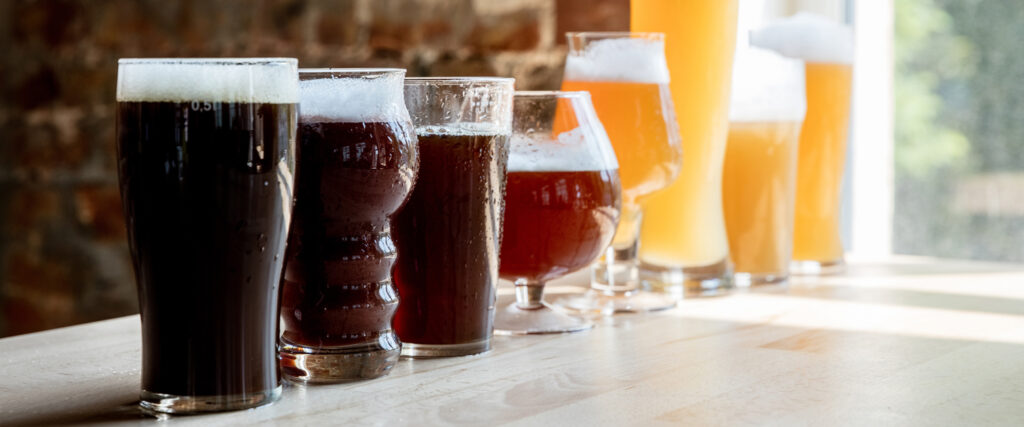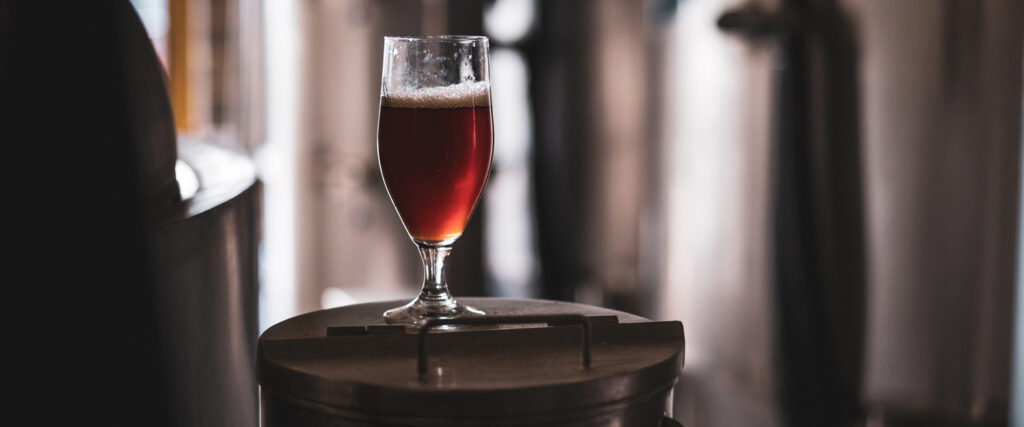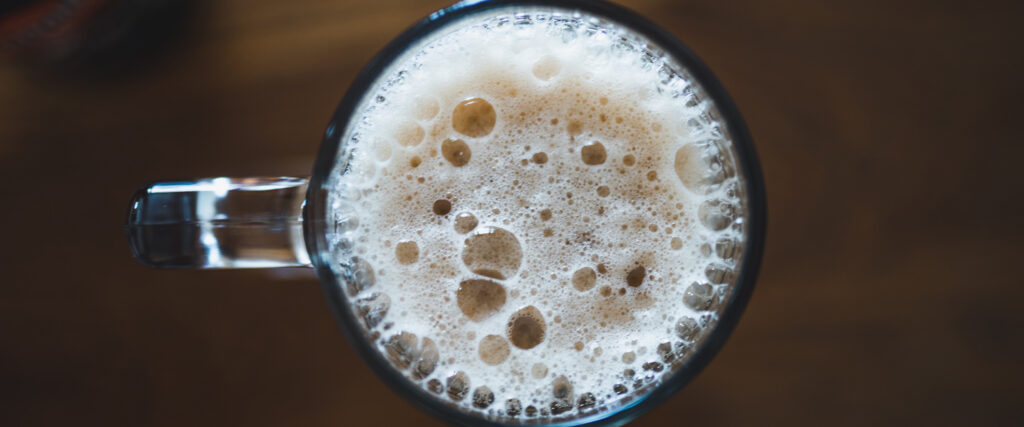Wild and Sour Beer is fermented using wild or natural yeasts, giving them a unique flavour. This was most likely how beers were brewed thousands of years ago. Modern brewers still use these methods; however, is there a future for wild and sour beer? Matthew Curtis gives us his thoughts and experience on the subject.

I sometimes think about what my beer cellar looked like in 2013. These days, I don’t keep too much beer at home—maybe a few bottles of nice lager, a couple of West Coast IPAs waiting to be cracked after a particularly stressful day, and the odd classic bitter or stout (because they’re great to have on hand when cooking a stew.) There’s a few big bottles but no longer anything seriously resembling what I’d call a ‘collection’.
A decade ago, however, I attempted to amass a serious number of rare and exciting bottles. I even kept a record of them in a spreadsheet. There were imperial stouts and barley wines aplenty, but the most cherished bottles were my collection of wild and sour beers. Chief among these was a selection of Lambic and Geuze, largely sourced from Belgium’s Boon, Cantillon, Tilquin and 3 Fonteinen breweries.
Although priced higher than a typical pale ale, squirrelling away a big bottle of sour beer didn’t seem like too much of an indulgence at the time. Especially when, at the back of my mind, I knew I was saving them for a special occasion, or the opportunity to wow my friends with something that, at one time, I considered to be exceptionally rare, and therefore collectible.
Much like the beers themselves, my feelings about keeping bottles back evolved with time. Without a proper, temperature controlled cellar (which was essentially a cupboard in my office that got very hot in the summer, and very cold in the winter) when I finally opened some of them, there were as many disappointments as there were reasons to smile. It is profoundly deflating to have saved a nice bottle of Lambic for five years, only to hear the cork pop with a whimper not a bang, before pouring out flat, lacklustre beer. I’ve saved some bottles for almost a decade, only to end up with something that tasted of wet cardboard. Cellaring beer is a lottery, and I am not a gambling man.
Although I did find that it was usually the wild and sour beers that kept the best—perhaps due to them containing trace amounts of yeast such as Brettanomyces, and its propensity to gobble up any pesky, residual oxygen. Towards the latter stage of my beer collecting days I delighted in picking up bottles from an emerging range of British producers who were investing in producing these styles. Pretty much anything from Burning Sky was an instant hit (I recently opened some eight year old bottles of its Cuvée which were, quite frankly, outstanding). I also jumped on the Mills hype early, managing to secure six bottles of Foxbic—a blend of beer and cider, fermented on cider lees—at the time of its first release.
At some point, however, something changed. The lustre these beers once had gradually faded away as I was drawn instead to simple, delicious, mid-to-low ABV pints. Maybe it was coming out of the pandemic and missing pubs, or maybe it was the fact I just didn’t feel like I had the cash to invest in saving beer for several years, knowing that it would give me mixed results. I simply wasn’t buying these kinds of beers any longer.
It’s why, while recording an episode of The Pellicle Podcast with DEYA Brewery founder Theo Freyne, and tasting some of his own exceptional wild and sour beers, I asked him who’s actually buying this stuff.
“No one,” he replied with a chuckle. His response was clearly a little tongue-in-cheek, but we both understood that in this economy, making wood aged, blended beers for a hyper-niche audience that can take months, or even years to be ready, is an indulgence. In commercial terms, you’d probably call it a hiding to nothing.
In spite of this, many British breweries persist in producing these curiously tart, funky, complex, and—most importantly—delicious beers. DEYA and Burning Sky notwithstanding, others to have entered the category include Duration, Fyne Ales, Cloudwater, The Kernel, RedWillow and Full Circle to name a handful. Honestly, it’s rare these days to visit a modern brewery and not find a few ex-wine or spirit barrels filled with steadily maturing beer waiting to be blended and bottled.

What unites the breweries mentioned above is that they recognise these products are an indulgence, and their customers do too. Their core business is in their clean beers: pale ales, lagers and the like that sell in volume and keep the lights on. More often than not, the reason they make wild and sour beer is because of the old brewers cliché: because they like to drink it. Some of these breweries have certainly built a great deal more of their identity around these beers than others, Burning Sky and The Kernel in particular. But their 750ml bottle releases still only make up a fraction of their output, resulting in less of a financial burden.
More recently there have been a number of entrants to the UK wild and sour beer category that are boldly placing their stock in these styles alone, including Mills, Crossover Blendery, Little Earth Project, and most recently, Balance Brewing and Blending. The latter, based in Manchester, launched its first beer in 2022, and opened a taproom around a year later.
The existence of each of these breweries is a statement. A financial analyst would probably describe them as being commercially unviable. But a romantic? They would call them bold, boisterous, and even necessary. Beer would be a hopelessly boring place if we just had a handful of similar beers to choose from, after all.
Considering their existence, it still leaves me with the question: who’s buying these beers? Or perhaps more pertinently, who’s going to be buying them in the future?
Between about 2012 and 2017—there was a lot of debate surrounding what some called the ‘winification’ of beer. Largely inspired by large scale sour and wild beer projects in the US such as The Rare Barrel and The Lost Abbey in California, upstart British breweries began attempting to recreate them, often with mixed results. Still, it laid the platform for what we have now, and the amazing beers produced by the breweries I’ve already mentioned.
Traditionalists however, didn’t see this as experimentation and the exploration of new flavours in beer: they saw it as an attempt to dress what is essentially a working class product as something else—beer as gentrification, with a price to match. As a younger voice in beer at the time, I considered this great change to be one of the most important opportunities happening in beer. Imagine, 750ml bottles of beer and cider pouring in great restaurants and wine bars up and down the country! (I still smile knowing that RedWillow’s Biere de Coupage sits on the wine list at Manchester fine dining restaurant The French.)
One of the UK’s largest breweries, BrewDog, once sought to capitalise on the discussion around these beers by producing a massive wild and sour facility called OverWorks at its brewery campus in Ellon, Scotland. Touring the facility in 2017 I was in awe at the scale and ambition of the project. They even managed to put a Bretted pale ale called Funk x Punk into Tesco. Essentially the brewery’s attempt at recreating Orval, it was delisted by the supermarket chain after just a few months.
The US, which pioneered the upscaling of wild and sour beer production, also struggled to grab more widespread attention with these kinds of beers. The Rare Barrel ceased trading in 2022, its Berkeley-based facility acquired by San Francisco’s modern IPA maestro’s Cellarmaker. The following year The Lost Abbey announced it would be scaling down its operations, with another IPA focused producer, Pizza Port, moving into its base of operations north of San Diego.
While there was, understandably, a huge amount of excitement around these beers initially, their uplifted presentation and ability to pair so well with food imbuing them with the potential to open up beer to a host of new drinkers, the industry failed to understand that these products were incredibly niche.

It’s great that certain beer lovers buy and keep them for years to open at special occasions or at bottle shares. But what happens when these beer lovers’ cellars are at capacity and they’re sitting on lots of beer? They stop buying it, of course. Most breweries have realised that they need their customers to drink their beer, and quickly, if they’re going to succeed in selling them some more.
There is also the challenging issue of language, and how the terminology used to describe these beers has not been adjusted so that those beyond the hardcore fringes or beer fandom can easily understand them. Throughout this piece I have tried my best to stick to calling them ‘wild and sour’ because I feel it works best for you, the reader. But often these beers are actually neither.
Wild would indicate that there is an element of production without control, such as wild inoculation or ‘spontaneous’ fermentation. The reality is that most breweries making these kinds of beers will have a well looked after house culture, and a lab to keep it that way. Either that, or they are ordering yeast directly from a supplier. Some of these beers are most definitely sour, but that term, like acidic, tart or funky, can also have negative connotations because they can also be used when describing off-flavours.
Some brewers and drinkers will refer to this genre of beer as “mixed fermentation”—a useful term because it describes that they were fermented with and conditioned on multiple strains of yeast, and sometimes bacteria, which results in the low pH and tart character they so often possess. This term, however, loses all meaning once it enters the consumer space. While people have come to understand language such as ‘pale ale’, ‘lager’, ‘bitter’ etc, a term like mixed fermentation does little to genuinely and effectively describe how a beer looks, tastes, and why it’s more expensive than most other things on the bar, or shelf.
The Belgians have had some success with terminology, as people understand terms like Lambic and Geuze—this is why they are so protective of them. I pose that if producers really want drinkers to understand these beers in simple terms they need to collectively agree on a way to both categorise and describe them. Without proper terminology that helps to qualify their existence and sell them on merit, I consider that wild and sour beer will remain inaccessible to the majority of drinkers.
This curious genre of beers’ challenges are certainly bigger than its potential at the moment. But the positive side is that they do have potential. You only need to head to Balance’s Taproom in Manchester, or to Little Earth Project’s White Horse Pub in Suffolks and taste these beers for yourself to get a sense of it. The only thing I feel these producers need to understand is that, for the time being at least, these beers will remain the premise of the few, not the many, and it will take a true cultural shift in beer for that to ever change.
— Matthew Curtis